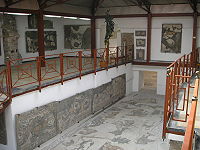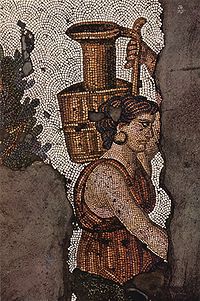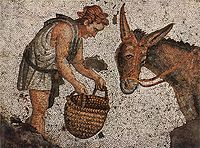
Istanbul Mosaic Museum
Encyclopedia

Istanbul
Istanbul , historically known as Byzantium and Constantinople , is the largest city of Turkey. Istanbul metropolitan province had 13.26 million people living in it as of December, 2010, which is 18% of Turkey's population and the 3rd largest metropolitan area in Europe after London and...
, Turkey
Turkey
Turkey , known officially as the Republic of Turkey , is a Eurasian country located in Western Asia and in East Thrace in Southeastern Europe...
, at Arasta Bazaar
Arasta Bazaar
The Arasta Bazaar in Istanbul is a small market close to the Sultan Ahmed Mosque. It is known for its jewelry, pottery, spice, textiles, and carpet shops. As opposed to the large crowds at the Grand Bazaar, the Arasta Bazaar is more low-key. Located at the Arasta Bazaar is the Great Palace Mosaic...
. The museum houses mosaic
Mosaic
Mosaic is the art of creating images with an assemblage of small pieces of colored glass, stone, or other materials. It may be a technique of decorative art, an aspect of interior decoration, or of cultural and spiritual significance as in a cathedral...
s from the Byzantine
Byzantine Empire
The Byzantine Empire was the Eastern Roman Empire during the periods of Late Antiquity and the Middle Ages, centred on the capital of Constantinople. Known simply as the Roman Empire or Romania to its inhabitants and neighbours, the Empire was the direct continuation of the Ancient Roman State...
period, unearthed at the site of the Great Palace of Constantinople
Great Palace of Constantinople
The Great Palace of Constantinople — also known as the Sacred Palace — was the large Imperial Byzantine palace complex located in the south-eastern end of the peninsula now known as "Old Istanbul", modern Turkey...
.
History of the site


Justinian I
Justinian I ; , ; 483– 13 or 14 November 565), commonly known as Justinian the Great, was Byzantine Emperor from 527 to 565. During his reign, Justinian sought to revive the Empire's greatness and reconquer the lost western half of the classical Roman Empire.One of the most important figures of...
(r. 527-565). It was uncovered by Turkey
British people
The British are citizens of the United Kingdom, of the Isle of Man, any of the Channel Islands, or of any of the British overseas territories, and their descendants...
archaeologists from the University of St Andrews
University of St Andrews
The University of St Andrews, informally referred to as "St Andrews", is the oldest university in Scotland and the third oldest in the English-speaking world after Oxford and Cambridge. The university is situated in the town of St Andrews, Fife, on the east coast of Scotland. It was founded between...
in Scotland
Scotland
Scotland is a country that is part of the United Kingdom. Occupying the northern third of the island of Great Britain, it shares a border with England to the south and is bounded by the North Sea to the east, the Atlantic Ocean to the north and west, and the North Channel and Irish Sea to the...
during extensive excavations at the Arasta Bazaar
Arasta Bazaar
The Arasta Bazaar in Istanbul is a small market close to the Sultan Ahmed Mosque. It is known for its jewelry, pottery, spice, textiles, and carpet shops. As opposed to the large crowds at the Grand Bazaar, the Arasta Bazaar is more low-key. Located at the Arasta Bazaar is the Great Palace Mosaic...
in Sultan Ahmet Square in 1935-1938 and 1951-1954. The area formed part of the south-western Great Palace, and the excavations discovered a large peristyle
Peristyle
In Hellenistic Greek and Roman architecture a peristyle is a columned porch or open colonnade in a building surrounding a court that may contain an internal garden. Tetrastoon is another name for this feature...
courtyard, with a surface of 1872 m², aentirely decorated with mosaics. It was at this point that the Austrian Academy of Sciences
Austrian Academy of Sciences
The Austrian Academy of Sciences is a legal entity under the special protection of the Federal Republic of Austria. According to the statutes of the Academy its mission is to promote the sciences and humanities in every respect and in every field, particularly in fundamental research...
, supervised by Prof. Dr. Werner Jobst, undertook to study and preserve the famous palace mosaic and to carry out additional archeological examinations (1983-1997) within the scope of a cooperative project with the Directorate General of Monuments and Museums in Turkey.

